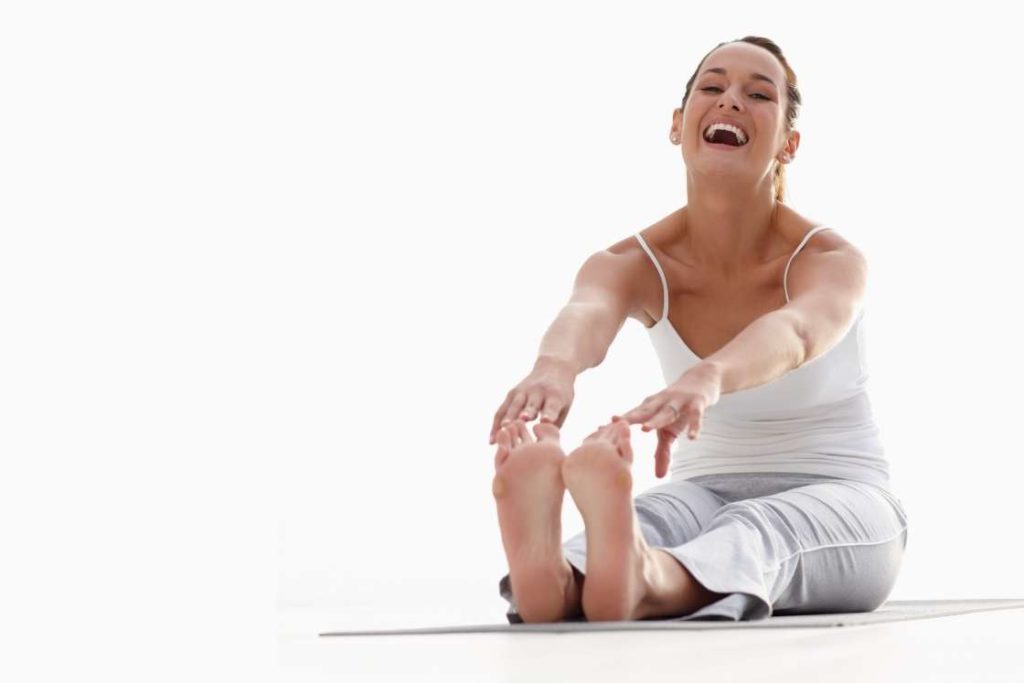- What it is
- Benefits
- Scientific claims
- Practice & exercises
- Laughter & yoga
- Impact on breathing
- Theories
- Simulated laugh

Laughter yoga is the practice to promote deliberate laughter which stimulated by a series of physical movements and breathing exercises. However in this yoga initially the laughter is simulated, after a session of practice soon it turns into real laughter.
The very basic idea of laughter yoga (in terms of practice) is to laugh without any humorous stimulation, however, the mind must not interpret the laugh as a fake one. The main aim of laughter yoga is to deal with stress, anxiety, and depression caused in the fast-paced materialistic world.
To begin deliberate laugh, the most common techniques used in laughter yoga are certain warm-up exercises, like stretching, clapping, eye-contact greeting, and chanting. These exercises are directed towards lowering the levels of inhibition. Then it’s followed by breathing techniques to prepare the lungs for a good laugh. And finally, different laughing exercises are performed.
How It’s started?
Though laughing therapy has been used for decades, laughter yoga first began as a club by a family physician Dr. Madan Kataria in Mumbai, India in 1995.
Dr. Madan Kataria in his book “Laughter Yoga: Daily Laughter Practices for Health and Happiness” mentioned that he was deeply inspired by an American Journalist Norman Cousins’s book “Anatomy of An Illnesses.” The book mentioned how cousins rejected traditional painkillers and watched funny movies, and used laughter to treat his ankylosing spondylitis.
He was equally intrigued by the research works of Dr. Lee Berk of Loma Linda University in California, showing that unfettered laughter reduces stress and impresses positive influence on the immunity system [efn_note] Laughter: A fool-proof prescription https://news.llu.edu/research/laughter-fool-proof-prescription [/efn_note].
Personal experiences and such documents led Dr. Kataria to incept the idea of a laughter club. He started the first laughter club with just 5 members. And today there are over 5,000 clubs worldwide.
Benefits

Very few other mind-body techniques are known to generate benefits as potent as those produced by laughter yoga. Laughter yoga can benefit anxiety reduction, heart rate variables, mood, and general overall health.
1. Psychological benefits
Laughter can regulate hormones like epinephrine, norepinephrine, dopamine, cortisol, serotonin, and HGH. The combination of these hormones is responsible for stress and different stress-generated physical difficulties. The psychological benefits of laughter yoga also include treating depression, panic attacks, and anxiety disorders.
2. Physical fitness benefits
Laughter yoga can help you be physically fit as well. It improves blood circulation and oxygenation. However, in aggregate many other physical benefits can be noticed, like:
- Cardiovascular improvements, including control blood pressure
- Higher respiratory performance
- Improves the functions of the autonomic nervous system
- Stimulates the digestive organs
- Boosts immunity
- Aids in treating conditions like diabetes, bronchitis, asthma, and other chronic ailments
3. Personality development
Laughter yoga improves your emotional stability, intellectual balance, and cognitive abilities. These personal developments help you develop a strong and impactful personality. It will increase your confidence, communication skills, expression ability, and social interaction skills. With a stress-free mind, you will also be able to reasonably self-analyze and self-reflect. Which can eventually yield spiritual benefits like self-realization.
Does it really work?
Studies showed that laughter yoga improved signs of physical and sleep disorders [efn_note] effect of laughter yoga on general health https://www.ncbi.nlm.nih.gov/ [/efn_note], reduced anxiety & depression levels, and improved the social functions.
In a 4 weeks yoga intervention program, it’s found laughter group as compared to the normal group has improved immediate mood and increased Heart Rate Variables (HRV) [efn_note] Effect of laughter yoga on mood and heart rate variable https://www.researchgate.net/profile/ [/efn_note].
The only issue is that laughter yoga might not be very visibly effective to people who are already very content with their life. A particular study on the subjective benefits of laughter yoga [efn_note] impact of laughter yoga on subjective well-being https://dro.deakin.edu.au/eserv/ [/efn_note] concluded that people who are already experiencing positive levels of well-being are not only less likely to attend laughter yoga, but gain almost nothing from the practice. On the plus side, laughter yoga has almost no contradictions, so you can still practice it for the regular yoga benefits.
Few other advocates of laughter yoga believe that it can increase the supply of oxygen to the body tissues, boost immunity, relieve pain, prevent cardiac diseases, diabetes, arthritis, migraine, and potentially cancer.
What makes laughter yoga important?
Laughter has a profound beneficial impact at a neurological and biochemical level. And this is the most significant benefit of laughter yoga. This benefit of laughter yoga is particularly relevant to present times when our lives are insufferable within the grips of stress and anxiety.
Following are few reasons that make laughter yoga a worthwhile consideration:
- Stressful work-life and relations
- Stress and anxiety very frequently leading to Depression
- A need to lighten the society riddled with intense conflicts
- Medical expenses are getting well beyond the reach of middle-class population
- As we grow up, statistically, our laugh frequency drops by 20 times [efn_note] Do Children Laugh Much More Often than Adults Do? https://aath.memberclicks.net/do-children-laugh-much-more-often-than-adults-do [/efn_note]
- When real laughter is hindered by our intellect, laughter yoga is the only option
- It benefits your physiology just like natural laughter
- Laughter yoga improves your lung functions
- When real laughter is hindered by our intellect, laughter yoga is the only option.
- It benefits your physiology just like natural laughter.
- Laughter yoga improves your lung functions.
Physiologically speaking laughter yoga can be more beneficial to natural laughter. Ideally, laughter needs to be sustained, deep, and unconditional. These traits are very rare in the laughter of a grown-up which is strictly governed by intellect and inhibition.
“Laughter yoga can help you achieve theoretically perfect laughter.”
Laughter yoga practice & exercises

Laughter yoga practice starts with a few warm-up stretches, clapping, and moving. It is then followed by a few deep breathing exercises and “ha ha” “ho ho” chants. These practices improve your pulmonary and muscular conditioning for laughter.
Just before starting the laughing exercises, the practitioners are encouraged to practice a few childlike playful cheers. Finally, you practice different types of laughing exercises.
Following are the most common laughing exercises:
- Namaste Laughter – Laugh while hands joined in Namaste
- Handshake Laughter – Shake hands with a partner and laugh
- Milkshake Laughter – pretend holding a glass of drink in each hand. Then pretend to pour one glass into another and then pretend to drink. And then laugh.
- Cellphone Laughter – Laugh while pretending to hold a cellphone
- Credit Card bill laughter – Laugh while pretending to display a credit card bill
- Just Laughing – pretend someone comes up to you asking the reason for your Laughter, and then you reply with a laugh in a manner of saying, “I don’t know why I am laughing.”
- Argument Laughter – Make physical movements with group members like pointing fingers and waving hands, but laughing at the same time.
- Lion Laughter – Open your mouth wide, bring your tongue out, like in simhasana, and laugh.
- Silent laughter – keep your mouth wide open but laugh without any sound.
- Gradient Laughter – Laughter starts from a giggle, and then gently increases in a gradient to a burst of hearty laughter.
- One meter laughter – laugh while measuring one meter with both your hands.
- Hot soup laughter – Stick your tongue out and pretend to cool down your mouth by waving your hand, like after eating a hot soup
- Electric shock laughter – Reach out to a group member to shake hands. Pretend to get an electric shock from contact, and then laugh at surprise.
The connection between laughter and yoga

To understand the connection between laughter and yoga, you must understand the true idea of yoga.
Yoga as a whole focuses on gaining control over the mind and the body. It trains you to unite the mind, body & soul with the common consciousness of all creations. In a simpler sense, yoga helps you integrate with society and the world around you.
Laughter is a mind-body phenomenon and the practice that teaches you to gain control over the process of laughing.
Laughter yoga helps the practitioner establish a yogic connection between mind and body through laughter; A laugh that can transcend beyond emotional and intellectual blocks, and uplift our consciousness towards the spiritual realm.
Initially laughter yoga was just a club; it didn’t entirely take the shape of yoga. However, it was noticed that practitioners faced physical challenges in sustaining, deep and unconditional laughter. The issues were many, both in terms of breathing and muscles involved in laughing.
This was when the scope of integration between laughter and yoga emerged. Dr. Kataria introduced a warm-up “ho ho” and “ha ha” chanting. He soon realized that this warm-up chant was essentially acting like the Kapalabhati Pranayama. Eventually, he built his entire warm-up routine with yogic stretches and Pranayama breathing techniques, to prepare the respiratory system and bodily muscles into aiding a perfect laughter session.
Laughter yoga impact on breathing
Warm-up breathing techniques of laughter yoga focus on slow and focused exhalation, which boosts the process of oxygenation. Everytime you exhale your lung removes carbon dioxide from the deoxygenated blood and replaces it with oxygen. The removed carbon dioxide is discarded through the exhalation.
This oxygenated blood carries oxygen to different parts and organs of the body; the oxygen triggers various biochemical reactions that cause growth, development, and healing.
Apart from the warm-up breathing techniques, laughter in itself is a form of extended exhalation. Our lungs generally hold 3 litres of reserve air, most of which is carbon dioxide. When we inhale our lungs expand to accommodate about extra 500 ml of air. On exhaling, we discard 500 ml of air as well.
Now through sustained laughter yoga practice, we inhale less and force out our lungs to exhale more. This force exhalation can remove up to 1.5 litres of the reserve 3 litres of air (which is mostly CO2.) On repeating this process the percentage of oxygen gradually increases in the reserved 3 litres of air.
The process of sustained laughter is also a wholesome exercise for your lung muscles, increasing their breathing capacity. Laughter yoga enhances your diaphragm, abdomen muscles, and parasympathetic nerves; all of which actively participate in respiration.
Laughter yoga philosophies and theories

Every popular belief system or practice spans across a set of theories and philosophies. Similarly laughing yoga works on the following principles:
1. Sense of humour
One of popular theory of laughter yoga is that laughter itself can generate a sense of humour. Which further encourages incidents of real laughter. This theory of laughter is based on the philosophy of inversing the cause and effect relationship.
Laughter yoga inverses the cause and effect relationship to gain greater control over laughter. Normally humour is considered the cause and laughter the effect. This makes laughter entirely dependent on the humour. Laughter yoga aims to inverse this relation, making laughter the cause and humour the effect. Naturally one develops greater control over the phenomenon of laughter.
2. Childlike laugh
Another philosophy of laughter yoga is that childlike laughter is unconditional. A child laughs without any reason, and simply from the inner joyfulness. Laughter yoga, thus consciously practices to develop the ability to laugh like a child.
3. Motion creates emotion
The physical activities of laughter yoga are based on the theory of motion creates emotion. This theory draws from the philosophy that our mind and body are integrally connected. Whatever our mind feels, our body does too, and vice-versa. Building on this idea laughter yoga includes physical motions that encourage the process of laughter.
4. Neuro-Linguistic Programming (NLP) theory
The next theory that inspires laughter yoga is that our mind and body can be trained to laugh. The Neuro-Linguistic Programming (NLP) theory states that our mind can associate physical behaviour with neuro-psychological responses. This means our minds can be programmed to associate laughter with certain physical behaviours.
5. Joy over happiness
And finally, laughter yoga emphasizes more on joy than happiness. As happiness is always conditional and fleeting. Happiness lasts momentarily.
“Whilst happiness is just a subjective state of mind, joy is a state of biological reality.”
Laughter generated from happiness will not last long. Hence laughter yoga focuses on developing a sense of joy, which is unconditional, everlasting, and a lot controllable. Laughter sessions generate joy and not happiness.
Does simulated laughing work?
The process starts as simulated laughing, yes, but with time, dedication and sincerity, most laughter turns into real laughter. Scientific research shows that simulated laughter itself can be a stimulus for real laughter. Another theory called the mirror neuron theory states that to some people laughing can be psychologically contagious. Meaning a person can burst into real laughter by seeing another person laugh.
Additionally, it has been scientifically proven that the body cannot distinguish simulated laughter from a real one. Even in pretense, your body goes through similar physiological and biochemical changes, as it would go through during real laughter.
A critical point to observe is that in both the cases of real and simulation, the process of laughter remains scientifically identical. It is just the initial stimulus that differs. And since the stressful life of an adult can provide a stimulus strong enough to trigger sustained and unconditional laughter, on a regular basis, laughter yoga is only the sensible choice.





